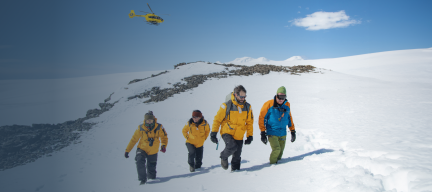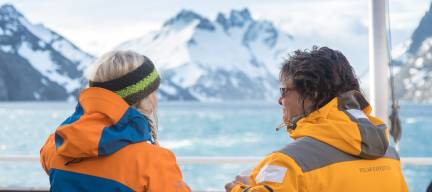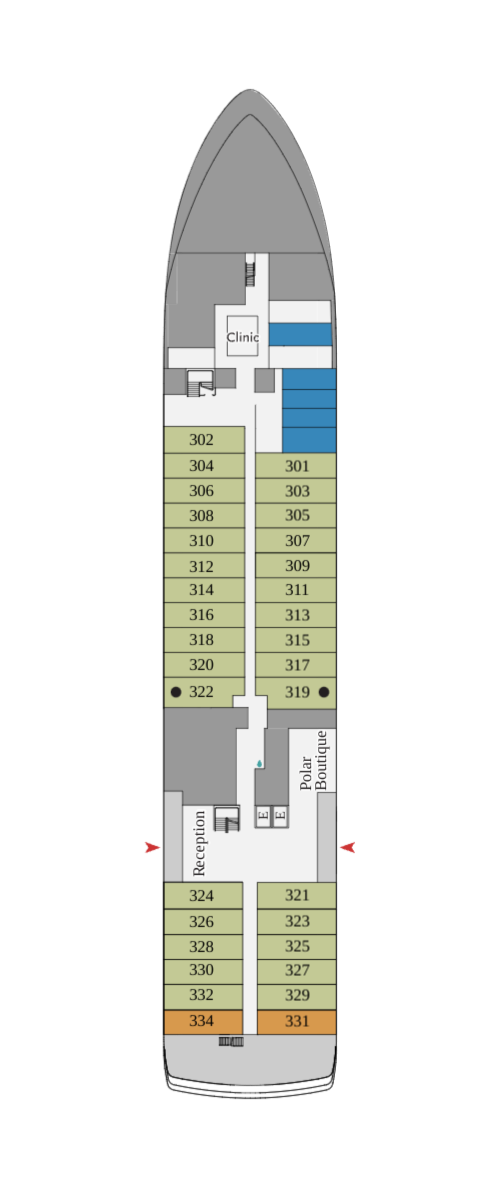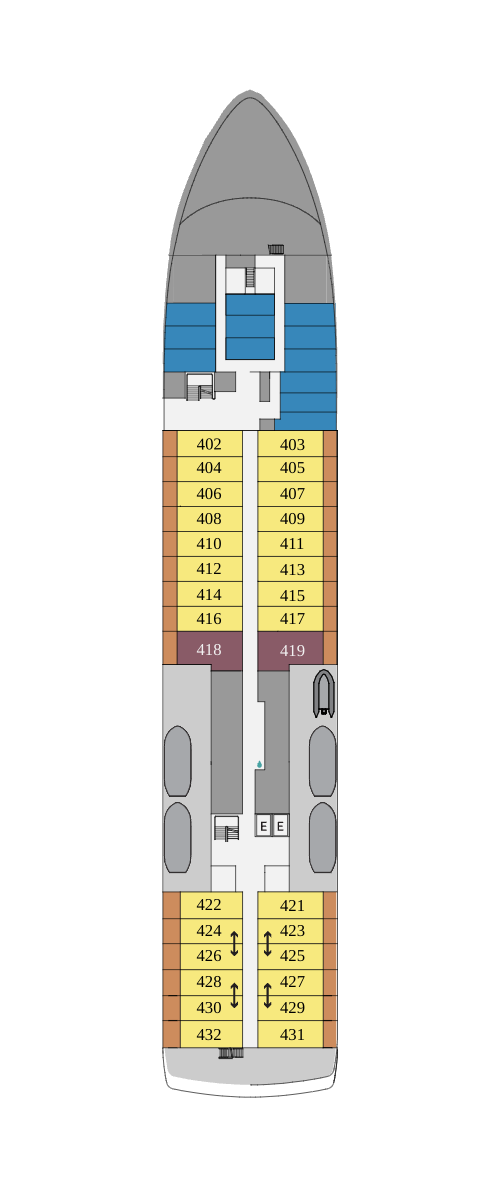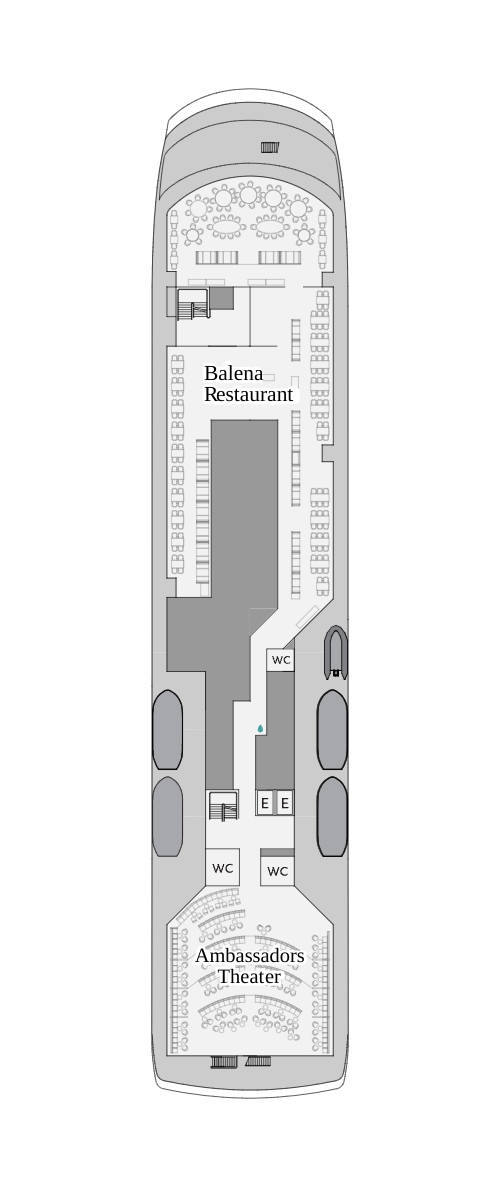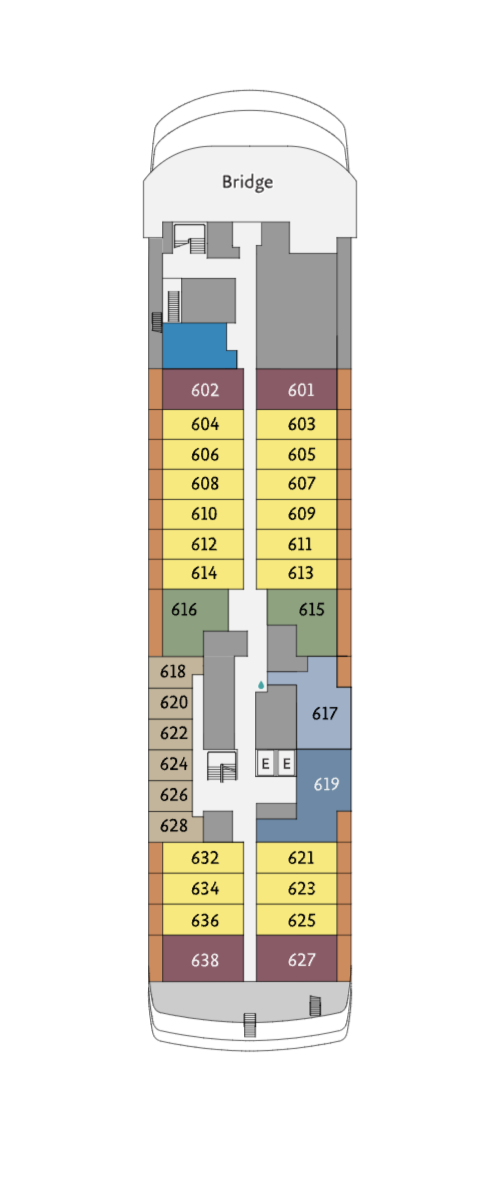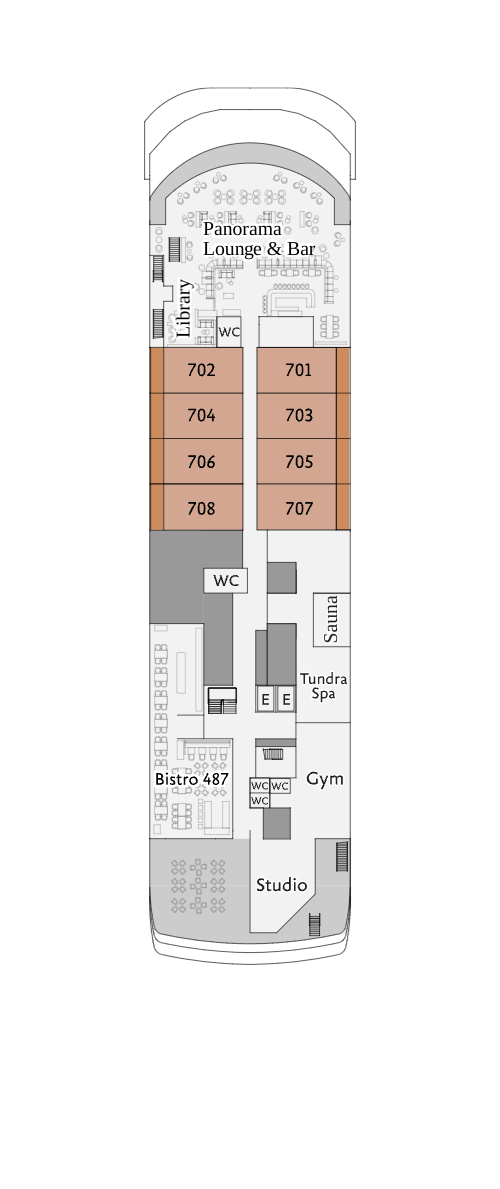Northwest Passage The Legendary Arctic Sea Route
Starting from
- Reykjavík, Iceland
Ships
- Ultramarine
- Ocean Explorer
Departures











Expedition Overview
Winding your way through the icy channels of the legendary Northwest Passage is history brought to life during this expedition in the Canadian High Arctic and Greenland. On this compelling 17-day journey, passengers retrace the steps of the intrepid Franklin Expedition, which left the shores of England in 1845 in search of the last unexplored section of the Northwest Passage—only to become permanently icebound. Its discovery more than a century and a half later by Norwegian Roald Amundsen was a much-celebrated moment in polar history.
Explore colorful Inuit villages, and shop for traditional Inuit handicrafts. Hike the endless Arctic backdrop and marvel at the vast, colorful tundra. Keep your eyes peeled for the elusive and majestic creatures that make their home in this wilderness, such as whales, walrus, muskoxen and polar bears. Come aboard for this immersive journey along the legendary Arctic sea route, and return home with memories permanently etched in your heart.
Highlights
Experience highlights of Greenland and the Canadian Arctic
Explore colorful Greenlandic villages and shop for traditional Inuit handicrafts
View iconic Arctic wildlife, such as whales, walrus and muskoxen
Hike the colorful tundra
Cruise in a Zodiac to get up close to glaciers, fjords, icebergs and more
Enjoy flightseeing on one of Ultramarine’s two twin-engine helicopters (Ultramarine departures only).
Find Your Ideal Itinerary
From Reykjavík, Iceland, 17 days, on Ultramarine
- Duration
- 17 days
- Departing from
- Reykjavík, Iceland
- Ship
-
Ultramarine
Learn more about the ship - Starting from
- $15,192 USD per person

Arrive in the Icelandic capital and make your way to your included hotel. You will have the rest of the day to explore the city on your own.
After breakfast, board your charter flight to Kangerlussuaq, a small community nestled deep inside a 118 mile (190 km) long fjord. Enjoy your first Zodiac ride as you’re transferred from shore to ship. Out on deck, take in your new surroundings before you set sail on your Arctic adventure.
Say goodbye to Greenland’s shores as you traverse the Davis Strait in pursuit of the Canadian Arctic. Presentations by on-board experts will prepare you for the adventures that lie ahead.
Visit towering fjords, historical sites and Inuit communities as you follow in the footsteps of famous explorers from long ago in the Canadian High Arctic.
At the southern tip of the Cumberland Sound, you’ll visit Cape Mercy, which was named by British explorer John Davis (yes, he of the Davis Strait), who sailed through it in 1585. This is the site of an old Distant Early Warning Line installation, dating back to the Cold War. These and many other stations were set up to detect Soviet bombers. It’s an ideal spot to go ashore for a hike.
As icebergs travel down the Davis Strait, they’re naturally trapped at Qikiqtarjuaq (formerly known as Broughton Island). The icy waters here are also home to ring and harp seals. A hike up to the hilltop inuksuk rewards with spectacular views of the community. Inuksuks are stone figures or cairns that traditionally call attention to the location for navigation, abundant harvesting or spiritual significance.
Cruising further north along the mountainous east shore of Baffin Island, we’ll approach Isabella Bay, an important summer and fall feeding area for the largest concentration of bowhead whales in Canada. Bowheads are a truly a remarkable arctic leviathan that research has revealed may live more than 200 years of age – the oldest mammal.
At the northern tip of Baffin Island, near the eastern entrance to the Northwest Passage, is the Inuit hamlet of Pond Inlet, surrounded by scenic mountains, fjords, glaciers and icebergs. Many in the community still follow a nomadic lifestyle and hunt for their food.
At the top of Baffin Island sits Lancaster Sound, a true arctic oasis. Known by the Inuit and their predecessors for thousands of years, this channel and the surrounding lands are extremely rich in wildlife and history, both indigenous and European.
The area around Lancaster Sound affords several hiking opportunities. At Dundas Harbour, on Devon Island, you’ll visit an abandoned beachside outpost of the Royal Canadian Mounted Police. At nearby Croker Bay, cruise in a Zodiac (at a safe distance) along the face of an actively calving glacier. Your Expedition Team will also keep its eyes peeled for walrus that are known to visit the bay. Farther west, some of the best ancient Thule remains in the Arctic are at Radstock Bay, beside the soaring Caswell Towers.
At the western end of Devon Island, the windswept Beechey Island is steeped in history. Named after famed British explorer Frederick William Beechey, it’s a Canadian National Historic Site. You’ll visit the small marked graves of three crew members who died during Sir John Franklin’s tragic 1845–46 expedition. Over 150 years later, Roald Amundsen landed here in 1903, during the first successful voyage by ship through the Northwest Passage.
Sailing down the east coast of Somerset Island, you may be fortunate to spot beluga whales and if you’re very fortunate, narwhals, as they feed at Creswell Bay. An Important Bird Area, the bay also attracts such species as black-bellied plovers, king eiders and white-rumped sandpipers. You’ll also have time to explore Fort Ross, where the Hudson’s Bay Company established a now-abandoned trading post in 1937. At the midpoint of the Bellot Strait, the narrow channel that separates Somerset Island from mainland North America, you’ll reach the northernmost area of the continental landmass, Zenith Point.
After disembarking in Resolute, you’ll be transferred to your charter flight to Calgary, where you’ll spend the night at your included hotel.
Today, make your way to the airport to catch your homeward flights, or spend the day exploring this unique Western Canadian city.
From Reykjavík, Iceland, 17 days, on Ocean Explorer
- Duration
- 17 days
- Departing from
- Reykjavík, Iceland
- Ship
-
Ocean Explorer
Learn more about the ship - Starting from
- $19,595 USD per person
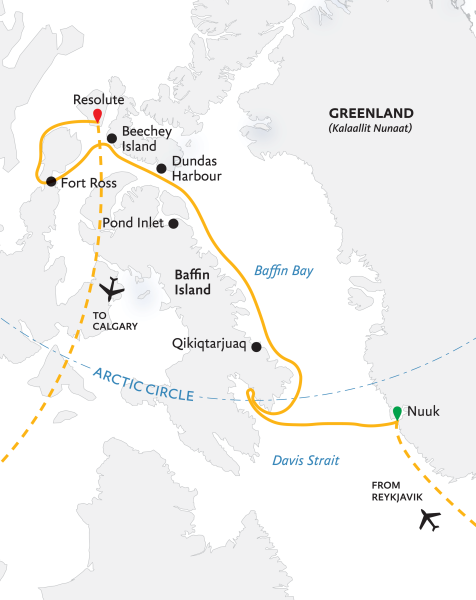
Your Arctic expedition begins in Reykjavik. Explore this vibrant city on your own before spending the night enjoying the comfort and amenities of your designated hotel, hotel, which is included in your Charter Flight & Hotel Package.
Ultramarine
Ship Amenities
- Ready Rooms
- Polar Boutique
- Ambassador Theater
- Balena Restaurant
- Bridge
- Bistro 487
- Tundra Spa
- Tundra Sauna
- Fitness Center
- Panorama Lounge and Bar
Ship Features
- 40-day Operational Range
- Four Embarkation Points
- MAGS
- Twin Engine Helicopters
- Water-level Zodiac Hangar
- Wraparound Deck

Ultramarine

Ultramarine Helicopter

Ultramarine Deck

Ultramarine

Ultramarine Balcony Suite (Double Bed)

Ultramarine Passengers

Ultramarine

Ambassadors Theater

Ultramarine Terrace Suite

Ultramarine Library

Ultramarine's Ready Room

Ultramarine Fitness Center

Ultramarine

Ultramarine Spa

Ultramarine Sauan

Andvord Bay
Ocean Explorer
Ship Amenities
- Main Dining Room
- Private Dining Room
- The Latitude Bar
- Library
- Dry Sauna
- Fitness Center
- Jacuzzis
- Observation Lounge
Ship Features
- Two Story Library
- Leading Edge Sustainability
- Ulstein X-Bow
- High Observation Outdoor Decks
- Quiet and Comfortable
- Stunning Interior Design

default

b898271c-219e-4203-bd40-20be0a749fc7

OEX-Atrium-ESP05657

OEX-Main-Dining-Room-ESP06890

OEX-Private-Dining-Room-ESP05760

9936371e-f5e5-4f46-aa68-80f1f3e4abcf

OEX-Tundra-Spa-ESP07005

OEX-Gym-ESP07057

OEX-Explorer-Lecture-Lounge-DSC02027

OEX-Polar-Boutique-ESP07075

OEX-Tundra-Spa-ESP07049

OEX-Observation-Lounge-ESP07254
Your Life Onboard






Enjoy panoramic views while you mingle in our comfy lounges, or head outside and chat with fellow adventurers on the wraparound deck. Our social spaces foster connections & shared experiences.

Engage with world-class experts in our auditorium. Presentations cover wildlife, history, marine biology, ecology, & geology, to enhance your polar knowledge & excitement for exploration.

Enjoy onboard amenities, attend lectures, or watch for wildlife from our observation decks. Sea days offer a perfect blend of education, relaxation, and anticipation.

Find tranquility in our well-stocked library, perfect for reading or quiet contemplation. The glass-domed Observation Lounge offers a peaceful retreat to reflect & enjoy awe-inspiring polar views.

Prepare for off-ship excursions in our spacious mudroom. Kayak, paddleboard, or take a plunge in polar waters. Stay active onboard with our gym, outdoor track, and pool facilities.

What’s Included
Specialist Expedition Leaders
Our team is comprised of the most professional and passionate Expedition Leaders in the world, who bring a wide range of experience and expertise to every adventure.
Immersive Off-ship Activities
Itineraries are packed with adventure options designed to immerses travelers in the polar wilderness, enabling them to connect with the natural wonders of their surroundings.
On-Ship Experiences & Facilities
Designed for comfort and adventure, each ship accommodates no more than 200 guests. Facilities include comfortable cabins, exceptional dining options, wellness treatments, and breathtaking panoramic views of the polar landscape.
Food & Beverages
Premium dining, with a wide selection of options that accommodate a variety of dietary preferences.
Quark Expedition Perks
Complementary Wi-Fi, alcohol on all voyages, and the Official Quark Expeditions parka to take home.
Transfers
Select voyages include essential transportation and accommodation arrangements for guests, ensuring seamless travel to and from the expedition starting point.
International airfare & visa expenses, travel insurance, mandatory expedition gear, on-ship expenses, adventure options and trip extensions are not included.
Included Activities

Flightseeing in the Arctic, Aboard Ultramarine

Hiking in the Arctic

Zodiac Cruising in the Arctic
Upgrade Your Expedition
Find out what add-on options are available for your expedition.
Adventure Options
These can be booked in advance at an extra cost. Activities vary by itinerary, destination and are weather permitting.
Trip Extensions

Reykjavík, Iceland
Not only is Reykjavík the social and cultural hub of Iceland, but it’s also one of the most walkable capitals in the world. Most of the city’s main attractions and venues can be reached on foot, which is not surprising for a capital with only 230,000 inhabitants. Iceland’s entire population is about 360,000. The country’s Viking roots are traced in Reykjavík’s major museums, yet the city, located on the southern shore of Faxaflói Bay, is the perfect base for anyone with a yearning to connect with nature and the outdoors. The range of options includes whale watching, geothermal pools, glacier walking, and kayak tours.
Possible Excursions
When traveling in extremely remote regions, your Expedition Team must consider the sea, ice and weather to guide the route and itinerary details. The following sites are a sample of what you may experience on your expedition, whether by ship, Zodiac cruise, helicopter, or shore landing.
Kangerlussuaq sits at the head of a 118- mile (190 km) long fjord. The tiny town has Greenland’s largest airport and a unique history. Although Inuit and their predecessors occupied or visited the area, Kangerlussuaq’s modern incarnation dates back to the U.S. occupation of Greenland as an air force base beginning in World War II.
NuukNuuk is the epicenter of Greenland’s fascinating emerging culture. At population 15,000, the world’s smallest capital city is a wonderful and curious mix of the traditional and the new. A particular highlight is the Greenland National Museum, which offers an insight into social change affecting the country from the 1950s onwards. Other exhibits include some of the the world’s oldest rocks (approx. 3.8 billion years found close to Nuuk), and the Qilakitsoq exhibit displaying the mummified remains of 15th century Inuit women and a six-month old child. The Katuaq Culture Centre and Nuuk Art Museum are also worth exploring.
This picturesque and remote community maintains strong ties to the land and sea, as its Inuit inhabitants have lived as nomadic hunters in this region for almost 5,000 years. The protective high hills and sheltered shores of this hamlet make for an ideal nesting habitat for various Arctic birds, including thick-billed murres, kittiwakes, ivory gulls and Ross’s gulls. Seals, narwhals and bowhead whales call the waters here home.
Beechey IslandNamed after Frederick William Beechey, an explorer with the Royal Navy, this is one of Canada’s most important Arctic sites and has been deemed a Canadian National Historic Site. During the Franklin expedition of 1845–46, two of Franklin’s ships, HMS Erebus and HMS Terror, anchored here with perilous results. Three of Franklin’s crew died here and are buried at marked gravesites.
Bellot StraitThe 1.2 mile (2 km) wide Bellot Strait separates Somerset Island from the Boothia Peninsula. During the transit, you’ll sail past the northernmost point of mainland North America, Zenith Point.
Cape MercyIn June 1585, British explorer John Davis (he of the Davis Strait) embarked on the first of three voyages to search for the legendary Northwest Passage. In August 1585, he reached this area at the northern entrance to the Cumberland Sound and named it Cape of God’s Mercy. Now known as Cape Mercy, it’s the site of a dramatic glacial fjord.
Croker BayOn the south coast of Devon Island is Croker Bay. A glacier here actively calves off chunks of ice, creating a birthplace for icebergs. The bay was a popular stop during the 1800s, when a path to the Pacific (the Northwest Passage) was at the forefront of Arctic exploration.
Fort RossIn 1937, the Hudson’s Bay Company established a trading post, named Fort Ross, on the coast of Somerset Island. Due to the harsh conditions and isolation of the post, it was closed in 1948. The store and manager’s house still stand.
PangnirtungWhen the Hudson’s Bay Company built a trading post in Pangnirtung in 1926, local Inuit families moved to the tiny settlement. A Royal Canadian Mounted Police detachment was established two years later. A hospital opened in 1929, but it wasn’t until 1962 that most of the Inuit who lived on Cumberland Sound relocated to Pang. The community has become internationally renowned for the tapestries and prints by local artists.
Pond InletEuropeans have been visiting the area that came to be known as Pond Inlet since the 1600s. The first visitors arrived seeking the Northwest Passage. In the 1800s, whalers brought wood and barter goods to the community. These visitors were latecomers, as the indigenous peoples had been living in the region for thousands of years.
Prince Leopold IslandImpressive, vertical cliffs surround part of this small island. This creates an ideal environment for nesting seabirds, and they nest here in vast numbers—more than 300,000 strong! Thick-billed murres, black guillemots and northern fulmars are most commonly seen here.
QikiqtarjuaqKnown until 1998 as Broughton Island, Qikiqtarjuaq boasts some of the highest mountains in North America east of the Rocky Mountains. From the cape, multitudes of icebergs can be seen coming down Davis Strait, and the rich arctic waters are home to numbers of seals and whales.
ResoluteOne of Canada’s most northern settlements, Resolute was formed by forceful relocation of Inuit from northern Quebec by the Canadian government in 1953, during the Cold War. Today, it’s also a jumping off point for much high Arctic research. It has everything from a grocery store and cable TV to a school and a couple of hotels. About 200 people live in Resolute throughout the year, where hunting and logistical support to research, mining and tourism contribute to the community’s economy.
Departure Dates & Cabins
Know Before You Go
For your personal safety—and to ensure you get the most enjoyment out of your polar adventure—please assess your mobility and medical requirements before booking. It is essential that guests have a high level of mobility to get in and out of Zodiac boats, and for off-ship activities such as hiking on uneven terrain. Our destinations are remote. Apart from our basic ship infirmary, it could take up to 72 hours to reach adequate medical facilities. For more details to help you assess your mobility and medical requirements before booking your voyage, please review Health & Safety.
Some of our expeditions have included transfers and these will be detailed in your Invoice and Trip Brochure.
Please note that if you have an airport transfer included in your trip, it is only available if you arrive on Day 1 of the itinerary. Please ensure your flight information on your Passenger Forms is up to date so our ground crew know when to expect you. There will be someone with a sign in Arrivals waiting for you. Please look for them and they will direct you to our group shuttle.
If you do not have included transfers, or you are arriving before Day 1, you will need to make your own way to the hotel. Most airports we travel in and out of have good taxi ranks in the Arrivals area, or you can often prebook a transfer online.
Packing is an exciting part of the trip for many of us. You will find a handy packing list towards the end of your Trip Brochure. You will have received a copy of this when you first booked. We also have two excellent videos, which you can check out here: What to Pack
Our Protection Promise allows you to make a purchase decision that will leave you worry-free in the event your plans change down the road. Please review details for each term in our Quark Expeditions Protection Promise.
Whether you are thinking of an expedition, or you’ve booked the trip of a lifetime with Quark Expeditions, review all our FAQs for comprehensive tips to help you prepare for the Polar Regions and how to make the most out of your voyage with the most experienced expedition team in the industry. If your specific question isn’t covered below, please reach out to your Polar Travel Advisor or helpful Client Experience Team at guest@quarkexpeditions.com.






